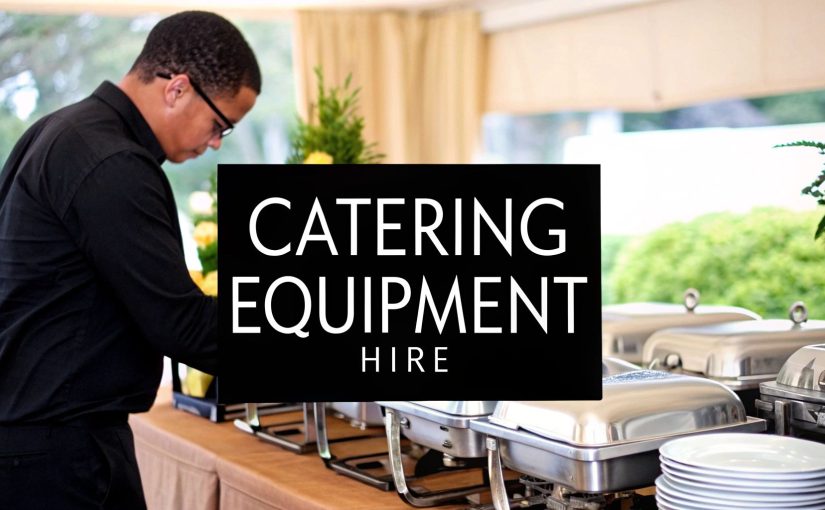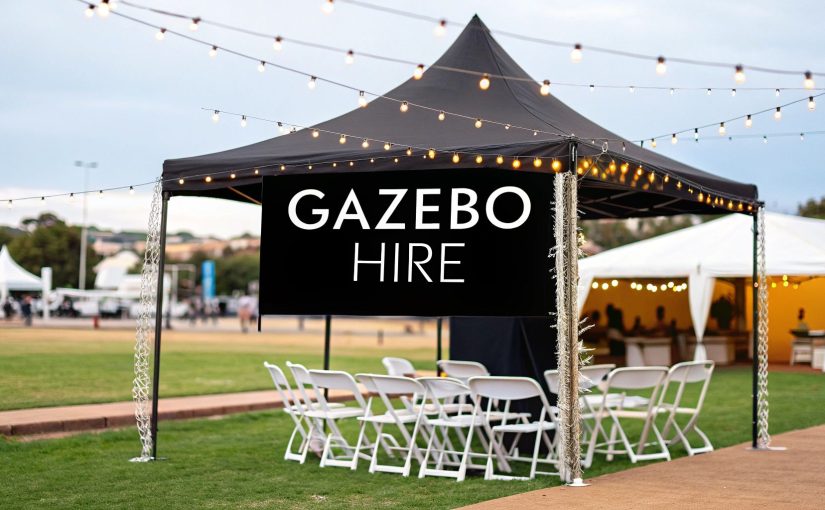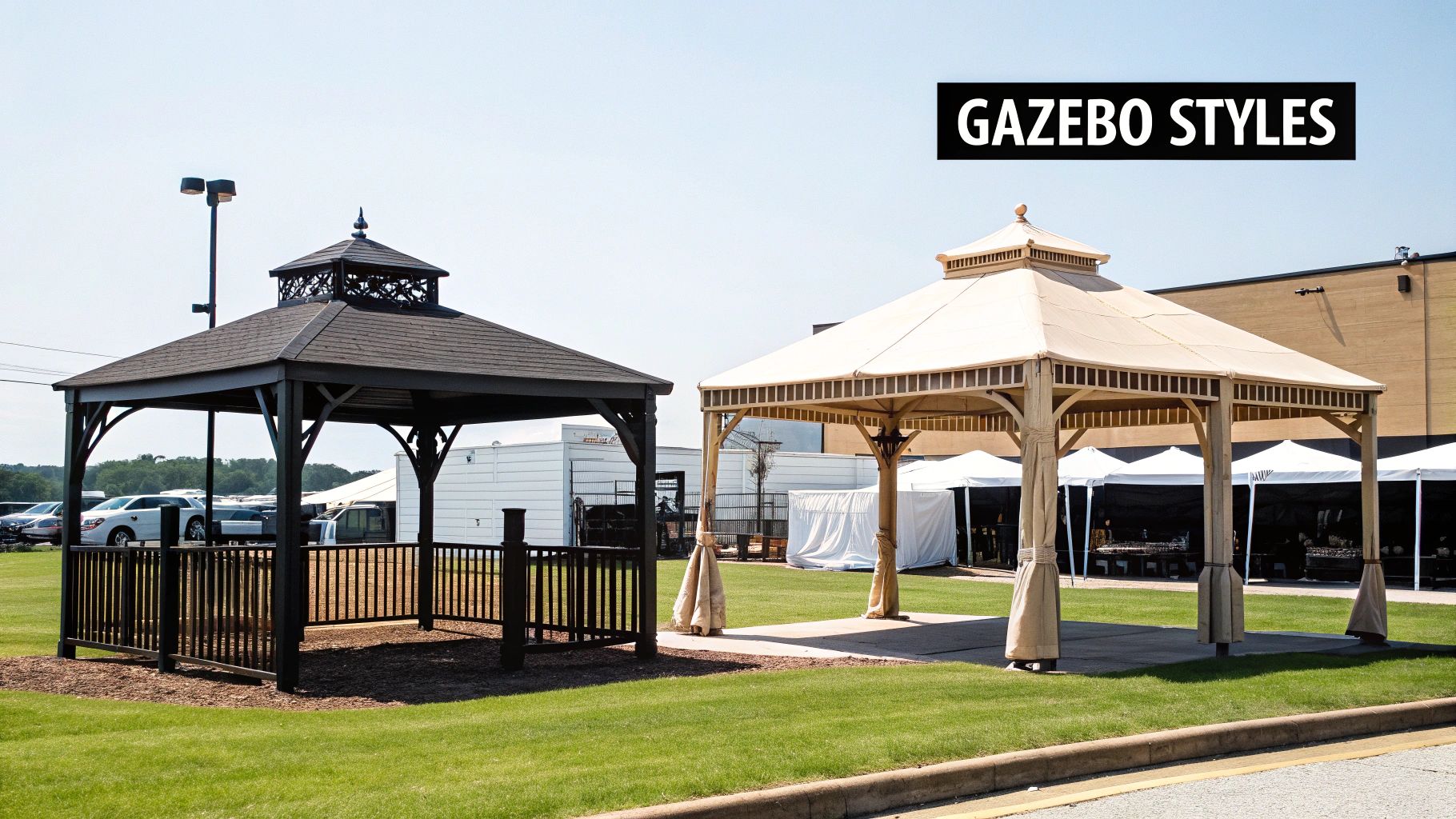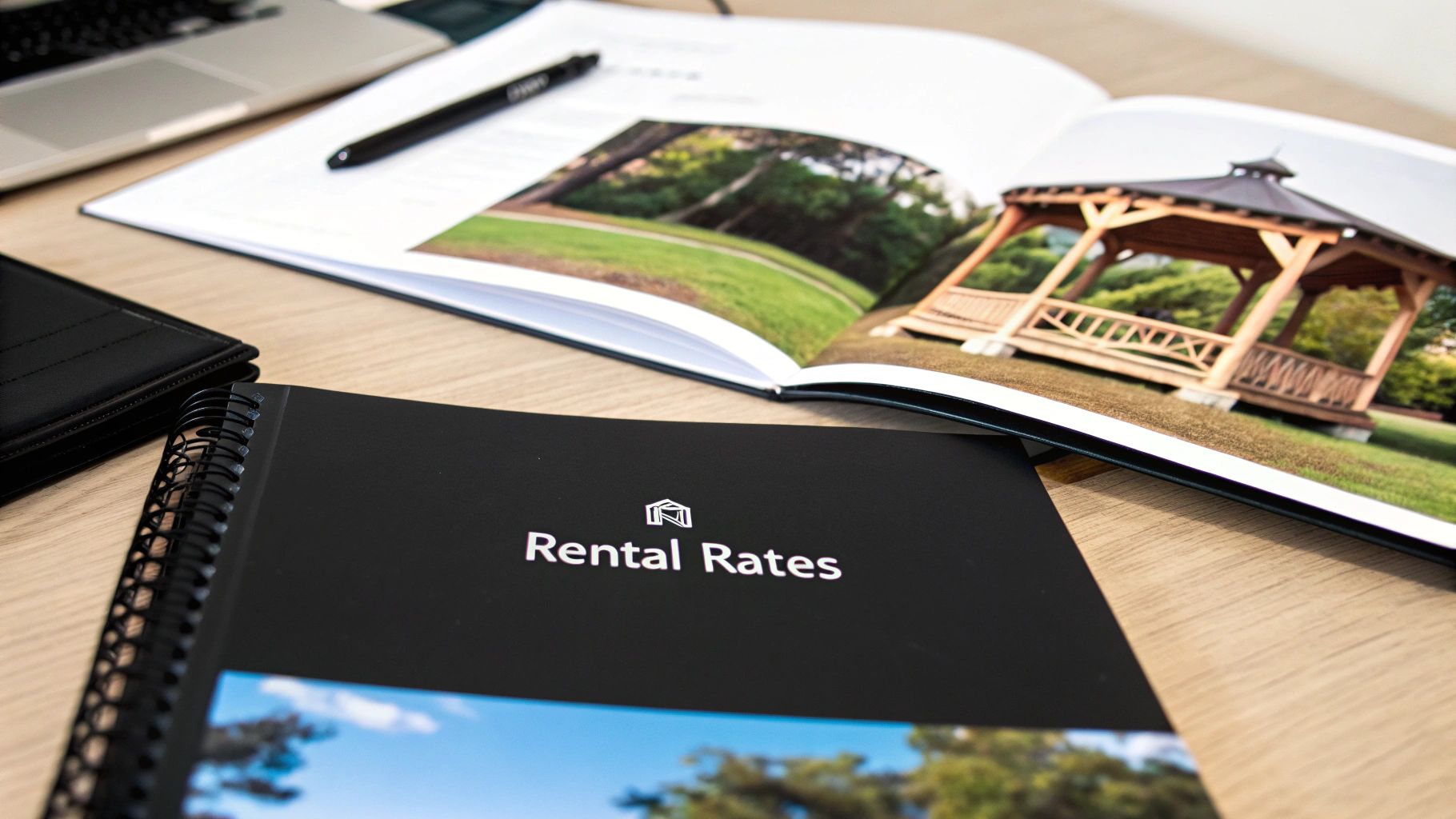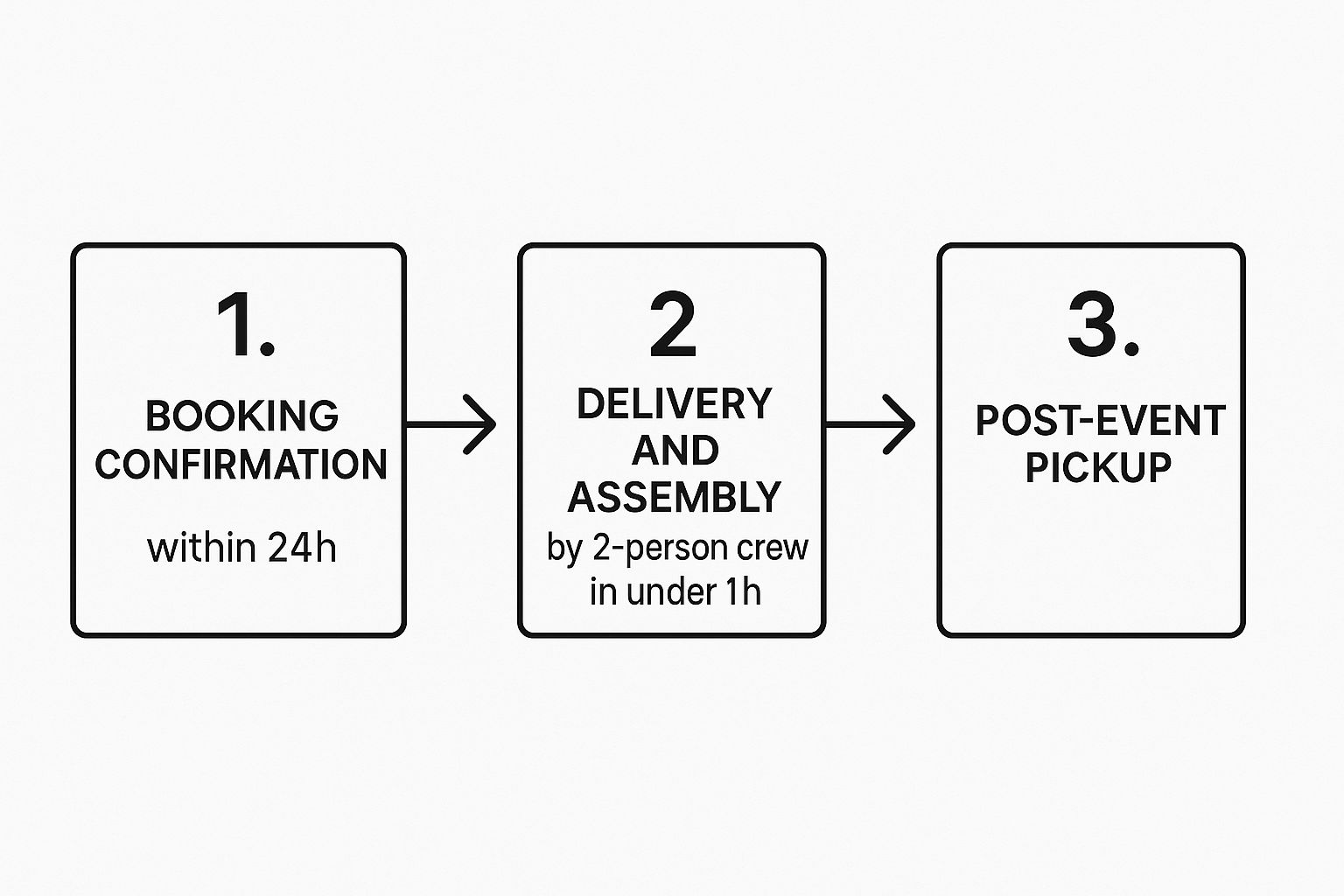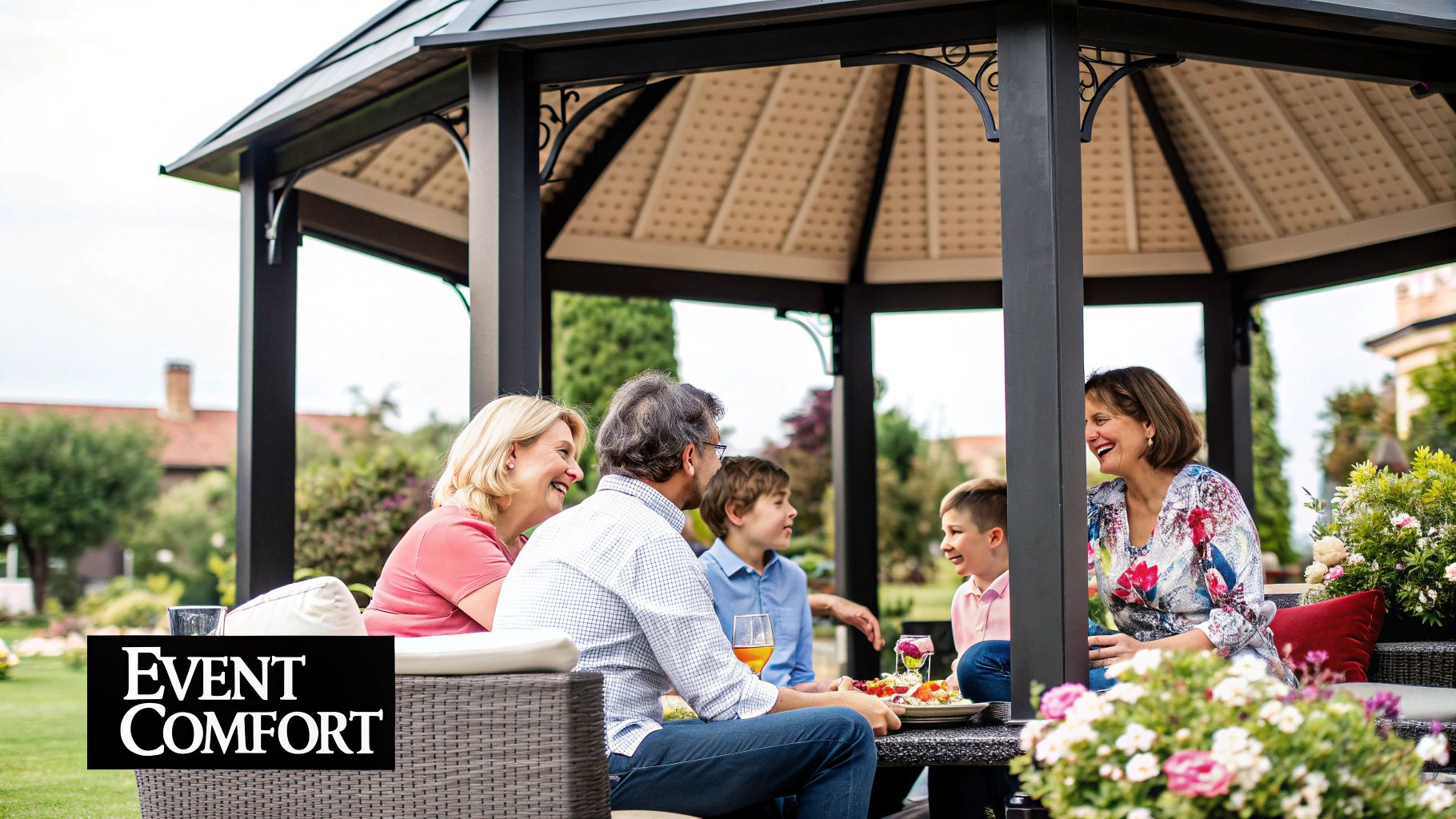Here’s the rewritten section, crafted to sound like an experienced event professional sharing their insights.
The secret to a flawless event isn’t just about a brilliant menu—it’s having the right tools to bring it to life. Knowing how to navigate the world of catering equipment for hire is what separates a smooth, professional function from a logistical nightmare. This guide is your practical roadmap for getting it right, especially for events here in South Africa.
Planning Your Event From the Ground Up
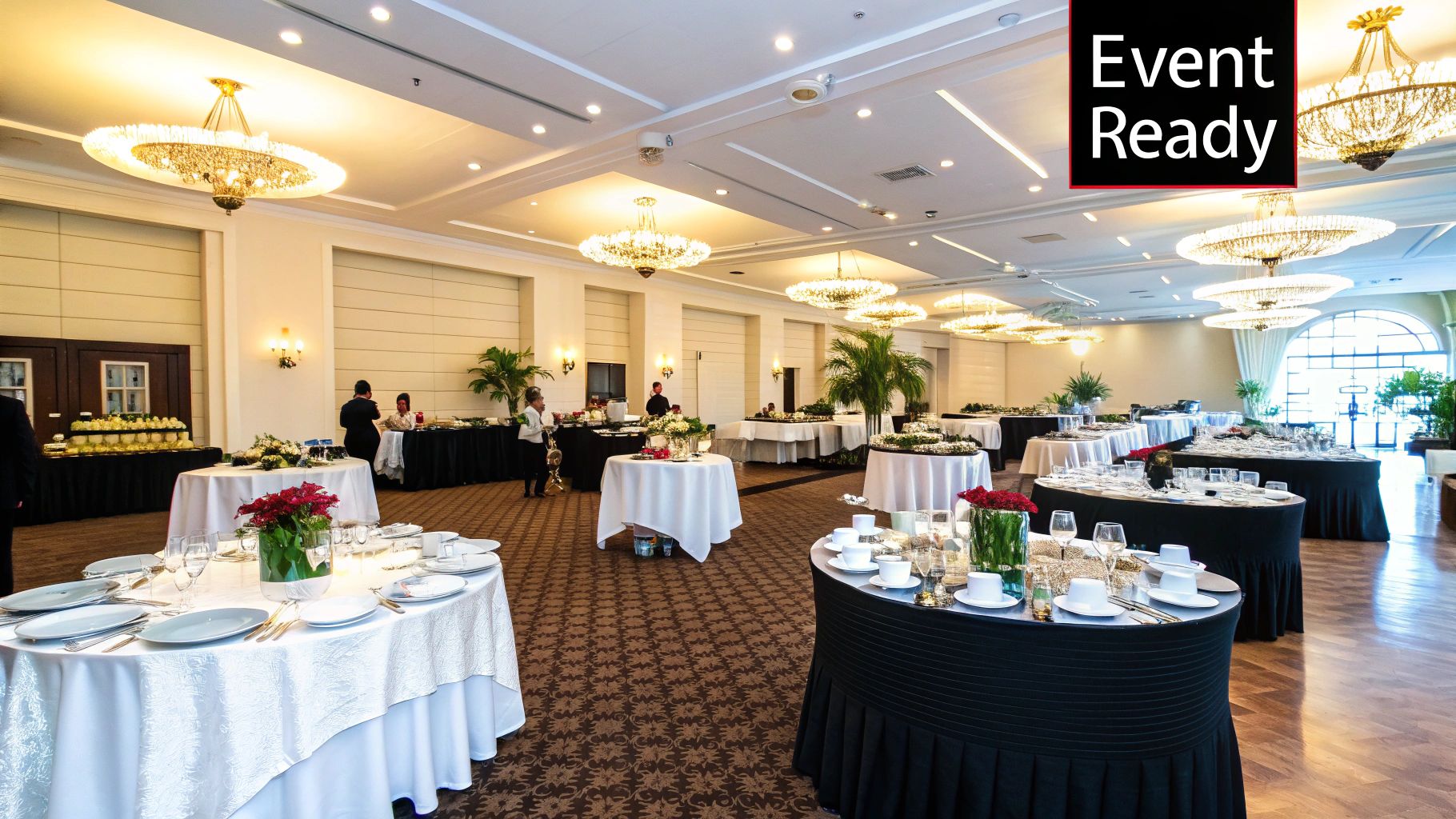
Before you even think about flipping through a rental catalogue, you need to start with a thorough needs assessment. This goes way beyond just counting guests. It’s about understanding the entire ecosystem of your event, from the complexity of your menu right down to the limitations of your venue.
After all, a multi-course plated dinner at a Johannesburg corporate gala has vastly different equipment demands than a relaxed braai wedding in the Winelands.
This is the planning phase where you head off last-minute chaos before it even has a chance to start. By asking the right questions upfront, you give your culinary team the power to perform at their best, ensuring every single dish is served perfectly.
Mapping Your Core Requirements
Take a moment and think about the entire service flow, from the first prep station to the final cleanup. This big-picture view is your best bet for spotting potential bottlenecks and equipment gaps you might otherwise miss.
I always break it down into these key areas:
- Menu Complexity: Is it a simple cocktail reception needing little more than glassware and bar gear? Or is it a gourmet dinner that requires a fleet of ovens, holding cabinets, and specialised plating tools?
- Venue Facilities: This is a big one. Does your venue have a fully equipped kitchen, or are you essentially building one from scratch in a marquee out in a field? This single factor determines your need for mobile kitchens, extra refrigeration, and even power sources.
- Guest Experience: The style and atmosphere you’re aiming for will dictate the type of crockery, cutlery, and even furniture you’ll need to hire.
The real goal here is to move beyond a simple shopping list. A truly effective plan anticipates the entire flow of the event, making sure your team has everything they need, exactly when they need it. This kind of foresight is the hallmark of a seasoned event professional.
A great way to keep everything straight from the get-go is by using a structured framework. To help you with this, you can download a comprehensive event planning checklist template that covers all the critical stages you’ll face.
Essential vs Nice-to-Have Equipment
Once you have a broad overview, it’s time to get practical and categorise your list. I can’t stress this enough: differentiating between what’s essential and what’s merely optional is crucial for keeping your budget in check.
An essential item is something without which the service simply cannot happen—think ovens for a hot meal or refrigerators to guarantee food safety. No compromises there.
A “nice-to-have,” on the other hand, might be a chocolate fountain or a specialised cocktail station. Sure, these items add flair and can elevate the experience, but they aren’t critical to the core service.
This kind of prioritisation lets you secure the non-negotiables first. Then, you can see what’s left in the budget to add those extra touches that enhance the guest experience. It’s a strategic approach that ensures your catering equipment for hire budget is spent wisely, not wastefully.
Defining Your Actual Equipment Needs
Before you even think about looking at a single rental catalogue, you need to get crystal clear on what your event actually requires. This is about more than just counting plates and forks. Nailing this assessment is the bedrock of a smooth-running event, and it’s what will save you from those frantic, costly, last-minute calls for forgotten gear.
Think of it as creating a detailed blueprint for your entire service. A relaxed braai in the garden has a completely different equipment footprint than a formal, multi-course plated dinner. The complexity of your menu is always the first piece of the puzzle.
Just as important is your venue. An outdoor marquee wedding in Stellenbosch throws up unique challenges—like figuring out power generation and mobile refrigeration—that simply don’t come into play in a Cape Town hotel ballroom with its own professional kitchen.
Analyse Your Venue and Service Flow
Every single venue has its own quirks, capabilities, and limitations. The first thing you should do is a thorough site visit, but with a critical eye for the existing facilities. You need to be asking yourself:
- What’s already there? Does the venue provide tables, chairs, or any basic kitchen equipment? Get a precise inventory list so you don’t waste money hiring things you already have.
- What’s the power and water situation? For any outdoor or remote location, you absolutely have to confirm access to reliable electricity for your ovens and fridges, plus a source for clean water. Don’t just assume it’s sorted.
- How will the service actually flow? Walk the path your staff will take, from the prep area all the way to the guest tables. This simple exercise helps you spot the need for service trays, trolleys, and holding stations to keep the food quality top-notch.
Understanding these nitty-gritty details is non-negotiable. It’s no surprise that the global party equipment rental market was valued at around USD 6.65 billion in 2024. The industry is booming because planners know they need specialised gear to make unique event spaces work. That demand is especially strong here in South Africa, where everything from corporate galas to vibrant cultural celebrations requires flexible and reliable equipment solutions.
From Cooking to Cleanup: A Complete Checklist
The only way to create a truly comprehensive list is to think through every single stage of the event. A simple way I like to organise this is by breaking it down into categories, from the back-of-house hustle to the front-of-house experience.
Cooking and Preparation
This is the engine room of your event. Your chef can’t work their magic without the right tools. Your list here might include things like convection ovens, gas ranges, deep fryers, and, crucially, enough food preparation surfaces.
Refrigeration and Storage
Food safety is one area where you can never cut corners. Make sure you have enough refrigeration units lined up—that includes bar fridges for drinks and mobile cool rooms for all your bulk ingredients. And don’t forget shelving for dry storage!
Serving and Holding
To make sure every dish arrives at the perfect temperature, you’ll need the right holding equipment. For a buffet, that means hiring high-quality chafing dishes and bain-maries. Our guide on choosing the right catering food warmers has some fantastic tips for keeping your food perfectly presented.
Pro Tip: Always, always hire more glassware and cutlery than your final guest count. A 10-15% buffer is my standard rule of thumb. It easily covers any accidental breakages, drops, or guests who wander off with their wine glass, ensuring your service never misses a beat.
To help you get started, here’s a quick look at how equipment needs can differ based on the type of event you’re planning.
Essential Equipment Checklist by Event Type
| Equipment Category | Corporate Gala (Plated) | Outdoor Wedding (Buffet/Braai) | Private Party (Cocktail) |
|---|---|---|---|
| Cooking | Convection Ovens, Gas Hobs | Large Braai Grills, Gas Burners | Combi-Oven, Fryers |
| Holding | Plate Warmers, Hot Boxes | Chafing Dishes, Bain-Maries | Small Food Warmers |
| Refrigeration | Upright Fridges, Under-bar | Mobile Cool Rooms, Ice Bins | Under-bar Fridges, Ice Chests |
| Serving | Service Trays, Waiter Stations | Buffet Risers, Serving Utensils | Cocktail Trays, Bar Stations |
| Furniture | Round Dining Tables, Banquet Chairs | Trestle Tables, Benches, Lounge Pods | Cocktail Tables, Bar Stools |
| Tableware | Full Cutlery Set, Chinaware | Melamine Plates, S/S Cutlery | Canapé Platters, Glassware |
This table just scratches the surface, but it shows how your core list will change dramatically depending on the event’s style and menu. Use it as a starting point to build out your own detailed checklist.
As you can see from the breakdown, the big-ticket items like heavy-duty cooking equipment will naturally take up a larger slice of your budget. On the other hand, essentials like tables and glassware are much more affordable per unit, which gives you more flexibility to play with numbers.
How to Choose the Right Rental Company
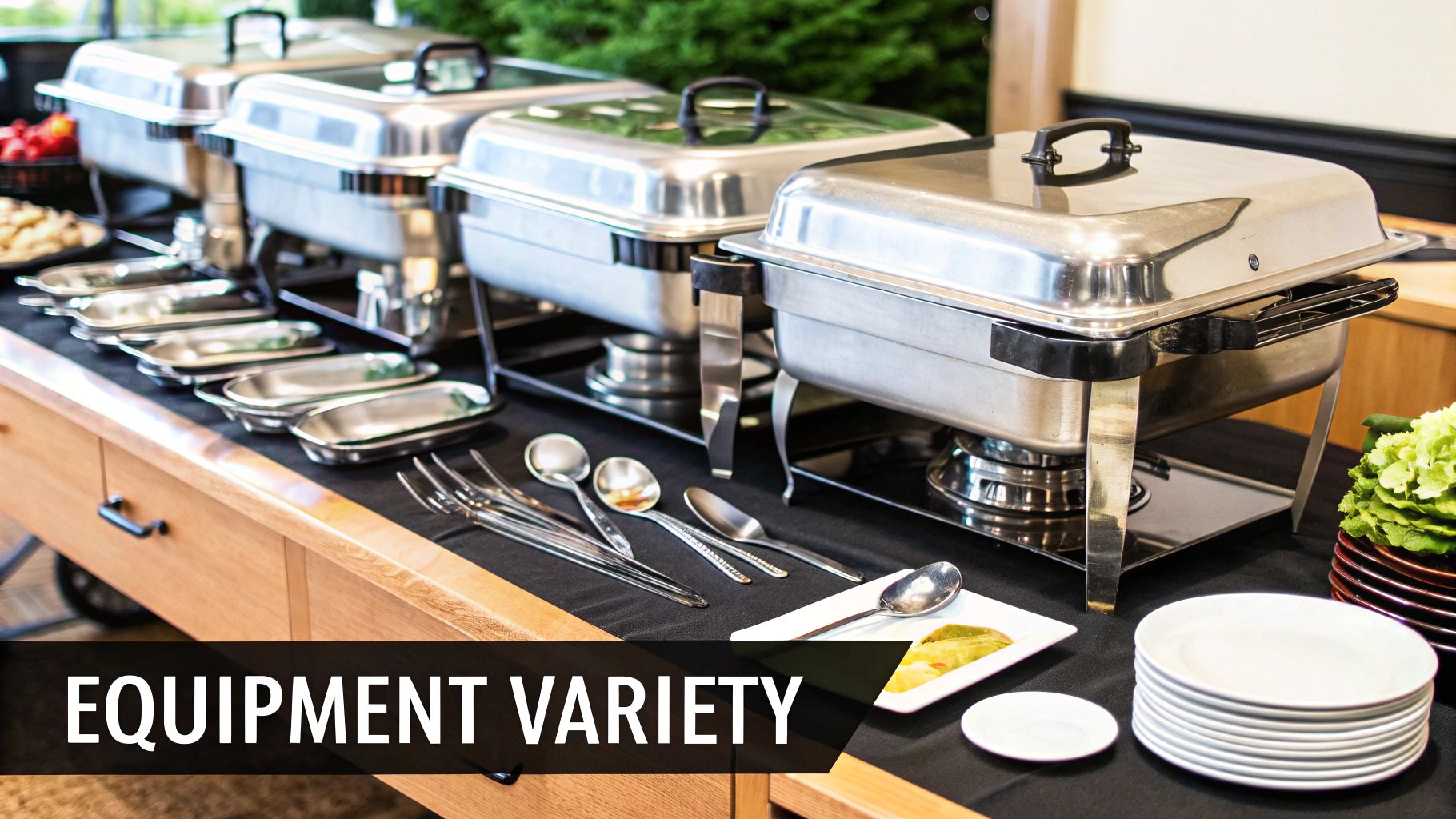
Choosing a supplier for your catering equipment for hire isn’t just a quick transaction; it’s about finding a partner you can trust. The right company feels like a natural extension of your own team, stepping up when you need them most. Get it wrong, and you could be inviting a whole lot of unnecessary stress to your event day.
It’s a simple truth: not all hire companies are created equal. Vetting potential partners is a step you just can’t skip.
Your first checks should always focus on the quality of their gear and their approach to hygiene. Don’t just rely on their website promises. If you can, pay them a visit. A trip to their warehouse lets you see the condition of the equipment with your own eyes. Is everything clean, well-maintained, and stored properly? The answer tells you a lot about their standards.
Look Beyond the Catalogue
A slick website is one thing, but a solid reputation in the real world is what really counts. Take a deep dive into recent online reviews on Google and social media. You’re looking for patterns here—what are people consistently saying about their reliability, communication, and the state of the equipment when it arrived?
Another great move is to ask for references from past clients who’ve run events similar to yours. A reputable supplier who’s confident in their service will have no problem putting you in touch. There’s nothing quite like an honest chat with someone who’s been in your exact shoes.
A great supplier doesn’t just drop off equipment. They understand the pressures of event day and have systems in place to support you. Their reliability is your peace of mind.
Key Questions Before Signing Anything
Before you put pen to paper, you need to be absolutely clear on their service level and all the nitty-gritty details. Go into that conversation armed with a list of questions so there are no nasty surprises later.
Here are the non-negotiables you have to clarify:
- Delivery and Collection Logistics: Get the specifics. What are their standard delivery and pick-up times? Do they offer tight time windows, or is it just a general “sometime on Tuesday” service? Make sure you know if the fee includes placing equipment where you need it or if it’s just a kerbside drop.
- Setup and Support: For more complex items like mobile kitchens or bars, do they offer a setup service? This is a huge help for bigger events. Looking into something like a mobile bar service for events can seriously streamline your entire beverage operation.
- Emergency Procedures: This one is critical. What’s the plan if a crucial piece of kit, like an oven or a fridge, gives up mid-event? Ask for their emergency contact number and get them to explain their after-hours support protocol.
- Cleaning and Damage Policies: Find out if you’re expected to return items sparkling clean. Some companies offer a “return-dirty” service for an extra fee, which can be a lifesaver. You also need to fully understand their damage waiver and what you’re liable for if something gets broken.
Getting straight answers to these questions upfront makes comparing suppliers a breeze and helps you lock in a partner who’s truly got your back.
Getting to Grips with Rental Contracts and Costs
Let’s be honest, the money side of hiring equipment can feel like a minefield. But getting your head around the costs and contracts isn’t just a box-ticking exercise—it’s what protects you, your client, and your budget. This is one of those non-negotiable steps if you want your event to run without a hitch.
First up, pricing. You’ll usually run into two kinds of quotes: package deals or itemised billing. A package deal might bundle everything—tables, chairs, basic tableware—for a set price per head. This is brilliant for straightforward corporate gigs or simple parties where you just need the basics sorted. Itemised billing, on the other hand, gives you the freedom to pick and choose.
Think of it this way: for a highly themed wedding where the couple has their heart set on specific vintage glassware and unique serving platters, you’ll absolutely need an itemised list. But for a standard conference lunch? A package could save you a ton of time and money. My advice? Always ask the supplier to quote both ways. You might be surprised which offers better value.
Don’t Skip the Fine Print in the Rental Agreement
I can’t stress this enough: never, ever just skim the rental agreement. That document is your safety net. It lays out exactly what you’re responsible for and is the first thing you’ll turn to if something goes sideways.
Pay very close attention to a few key clauses:
- Liability and Damage Waiver: This bit explains who foots the bill for broken or missing items. Often, you’ll see an option for a “damage waiver.” It’s a small fee you pay upfront that covers minor accidental damage. For the peace of mind it buys, I almost always take it.
- Insurance Requirements: Some hire companies will insist you have your own event insurance. Get clear on what their policy covers versus what you’re expected to handle. There’s nothing worse than finding out you’re on the hook for something major.
- Cancellation Policy: Life happens. A client might postpone, or guest numbers might plummet. Make sure you understand the penalties if you have to cancel or make big changes close to the event date.
A rental agreement isn’t just a formality—it’s a proper business contract. Any reputable company will be more than happy to talk you through clauses you don’t understand. If they get cagey or rush you, take that as a massive red flag.
Smart Finance Options to Help You Grow
Cash flow is the perennial headache for any growing business, especially in catering. This is where rental finance schemes can be a real game-changer.
Here in South Africa, the catering scene is incredibly diverse, covering everything from a casual braai to a black-tie corporate dinner. Many of the best in the business use rental finance to get their hands on top-tier equipment without a crippling upfront investment. This flexibility is crucial in a market that swings with the seasons. Smart suppliers will even tailor contracts to help you manage that ebb and flow. You can find more detail on how South African caterers use rental finance to stay competitive.
Essentially, this model lets you say “yes” to those bigger, more profitable events that might have felt out of reach. You’re paying for the gear while you’re earning from the very event you’re using it for.
How to Negotiate a Fair Deal
Finally, don’t be shy about negotiating. You’ve got to be smart about it, though. You’re not going to haggle over the price of a single plate, but there’s often wiggle room elsewhere in the contract.
Try focusing your discussion on these areas:
- Delivery Fees: If you’re placing a substantial order, it’s perfectly reasonable to ask if they can reduce the delivery fee or even waive it.
- Bulk Discounts: Hiring 500 chairs or 1,000 wine glasses? There might be a bulk discount they can apply. It never hurts to ask.
- Long-Term Hires: Need the equipment for a multi-day festival or a week-long conference? Ask for a reduced daily rate after the first day.
The goal isn’t to squeeze every last cent out of the supplier. It’s about landing a fair price without compromising on quality or service. A good negotiation ends with both sides feeling good about the deal and sets the stage for a great working relationship.
Mastering On-Site Delivery and Logistics
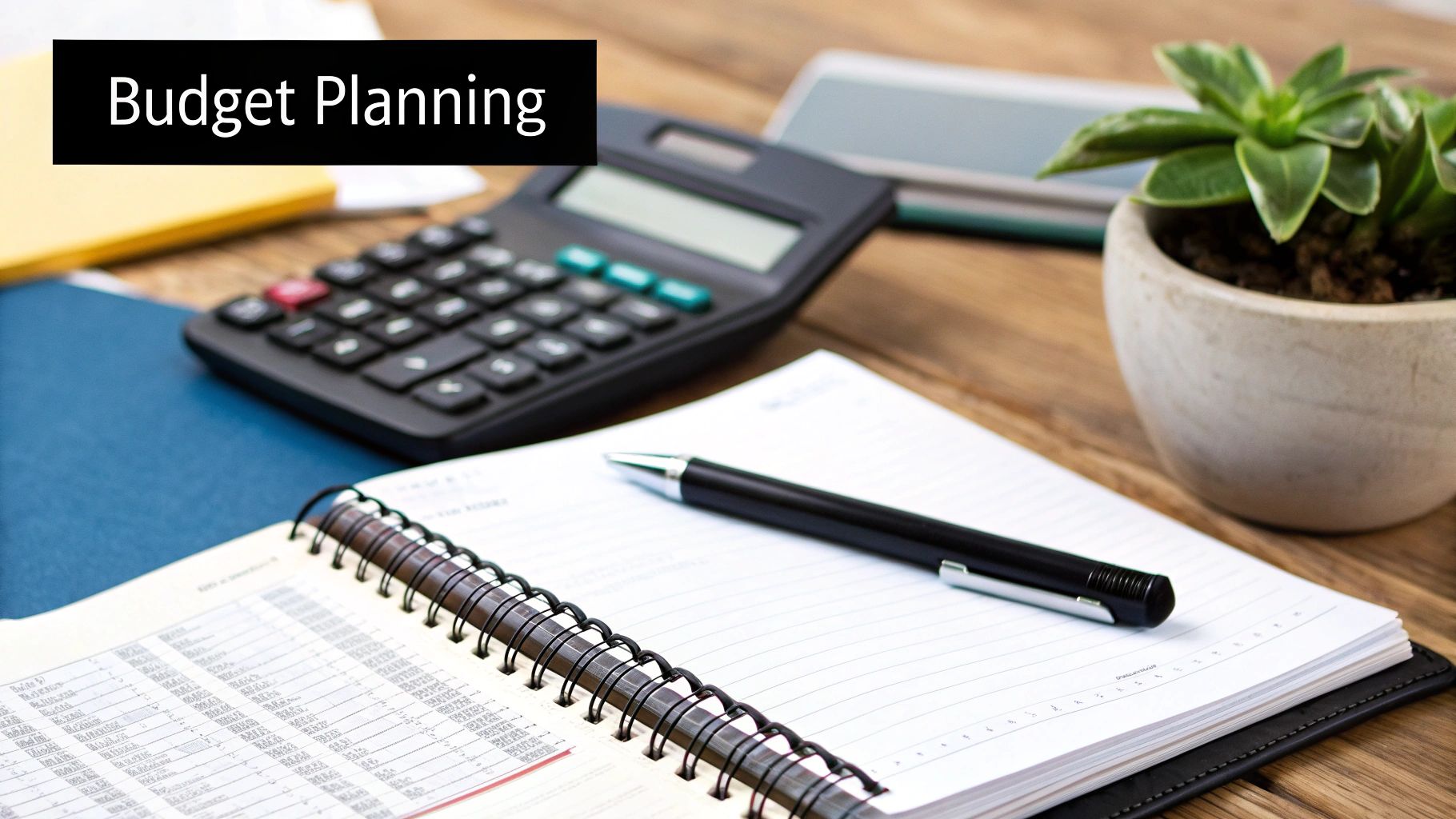
A fantastic event depends on flawless execution, and that starts long before your first guest walks through the door. Think of on-site logistics as the invisible framework holding everything together. It’s about ensuring every piece of hired equipment is exactly where it needs to be, right when it’s needed.
The goal? For your catering team to arrive on-site and get straight to work, without wasting a second hunting for gear or figuring out where things go.
This all comes down to a rock-solid logistics plan, which you need to share with your team and the rental company. Don’t just accept a vague delivery day. You need to insist on a specific window. A two-hour slot is infinitely better than “sometime on Friday morning,” because it lets you schedule your own staff properly and avoid having people stand around waiting.
Here in South Africa, we’re seeing more and more organisers choosing to hire big-ticket items like mobile kitchens and refrigeration units for everything from lavish weddings to major corporate functions. It’s all part of a bigger shift towards smarter, more flexible event planning. You can get a closer look at these market dynamics by checking out these catering equipment rental trends and insights.
Creating Your On-Site Logistics Plan
Your plan needs to be crystal clear, leaving zero room for interpretation. It’s the single source of truth for everyone on the ground.
Make sure your logistics brief includes these non-negotiables:
- A Designated Drop-Off Point: Be painfully specific. Is it the main entrance, a back loading bay, or a specific service gate? A simple map or clear directions can save a world of headaches.
- On-Site Contact Person: Name the one person who will meet the delivery crew, and include their mobile number. This person is your point-person for the most important step: the inventory check.
- Clear Timings: Nail down the delivery window, your setup deadline, and the exact collection time after the event wraps up.
Getting this level of detail sorted upfront prevents those nightmare scenarios. The last thing you want is a delivery driver calling you mid-service asking where to park a truck full of chafing dishes.
The Critical Delivery Check
As soon as that truck arrives, your designated contact needs to do a full inventory check before a single piece of paper is signed. This is non-negotiable.
With the final order confirmation in hand, they must physically count and inspect every single item unloaded from that truck.
I can’t stress this enough: do not skip this step, no matter how chaotic things get. Unpacking crates to discover you’re short 20 wine glasses or that a crucial oven won’t turn on is a crisis you can easily sidestep with a ten-minute check on arrival.
If you find any problems—missing items, the wrong model, or damaged equipment—document it on the spot. Take photos with your phone and get in touch with your account manager at the hire company immediately. Any professional company will have a plan for this. They’ll either rush a replacement out to you or make a note so you aren’t billed for the issue. This one simple check ensures your catering equipment for hire is ready to perform when the pressure is on.
Your Top Equipment Hire Questions, Answered
Even the most organised event planner has a few last-minute questions when it comes to hiring catering equipment. It’s completely normal. Drawing from years of experience in the industry, I’ve put together some straightforward answers to the questions we get asked all the time by planners and caterers across South Africa.
What Happens If a Piece of Hired Equipment Breaks Mid-Event?
This is the one scenario that can give any planner a sleepless night, but any professional hire company worth their salt will have a solid game plan for this. Your very first move should be to call their emergency number right away. Don’t wait until the event is over.
Most of the time, the supplier will try to talk you through a quick fix over the phone. If that’s not an option, they’ll either send a technician to your venue or get a replacement item on the road, depending on how urgent it is and what piece of equipment has failed.
It’s absolutely crucial to get clarity on this emergency process before you sign anything. Your rental agreement is key here, as it will spell out who is liable for what. A breakdown due to general equipment failure is almost always on the hire company. However, damage caused by your team using it incorrectly? That responsibility will likely fall on you.
Key Takeaway: A hire company’s true quality isn’t just in the gear they provide; it’s in how they handle a crisis. A clear, responsive emergency plan isn’t a nice-to-have, it’s a non-negotiable.
How Far in Advance Should I Book Equipment for a Wedding?
For any big event, especially during South Africa’s peak wedding season (which typically runs from September through to April), you really want to lock in your essential catering equipment three to six months in advance.
Trust me on this one. Speciality items, on-trend furniture styles, and large quantities of anything get snapped up incredibly fast. This is especially true for popular weekend dates in the Winelands or other sought-after wedding spots. Booking early does more than just secure your items; it gives you peace of mind and plenty of time to coordinate all the logistical details with your suppliers.
If you’re planning a smaller function or an event in the quieter off-season, you might get away with a one to two-month lead time. But the golden rule I always stick to is simple: book as early as you possibly can.
Am I Responsible for Cleaning Everything Before It Goes Back?
This is a big one, and getting it wrong can hit you with some unexpected charges. The standard practice across the industry is that you’re expected to rinse all food debris from crockery, cutlery, and glassware before packing them back into their crates.
That said, many hire companies now offer a “return-dirty” service, usually for a reasonable extra fee. This can be an absolute lifesaver for your crew at the end of a long, exhausting event day, freeing them up to focus on the main pack-down.
- Standard Return: Usually means scraping plates and rinsing all items of any food residue.
- Return-Dirty Service: You can return everything as is, for a pre-agreed additional charge.
Always, always double-check the “Cleaning and Returns” section in your hire contract. It will tell you exactly what’s expected and help you avoid any nasty surprises on your final invoice.
Does the Hire Price Include Delivery and Setup?
In most situations, the answer is no. It’s important to realise that the item prices you see listed in a catalogue are almost always just for the gear itself, separate from any logistical costs.
Delivery and collection are calculated as an additional fee, usually based on how far your venue is and the volume of your order. It’s also good to know that “standard delivery” often just means a “kerbside drop-off.” The delivery crew will unload the items at the closest accessible point, and that’s it.
If you need the team to carry equipment to a specific spot on the property, set up your tables and chairs, or help with the final pack-down, you’ll need to arrange this beforehand. This will be quoted as an extra labour charge. My advice is to always ask for a fully itemised quote that breaks down the equipment costs from all the delivery, collection, and labour fees. That way, you get a crystal-clear picture of your total investment.
Ready to create an unforgettable atmosphere for your next function? ABC Hire offers a premier selection of event furniture and accessories in Cape Town and surrounding areas. Explore our inventory and let us help you shine. Find out more at https://abchire.co.za.

